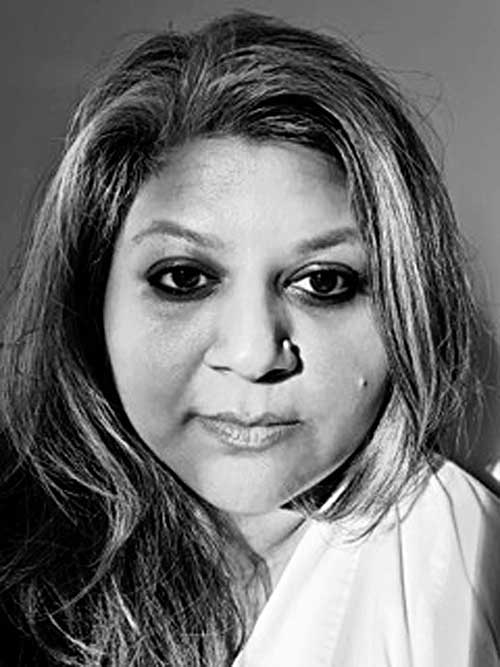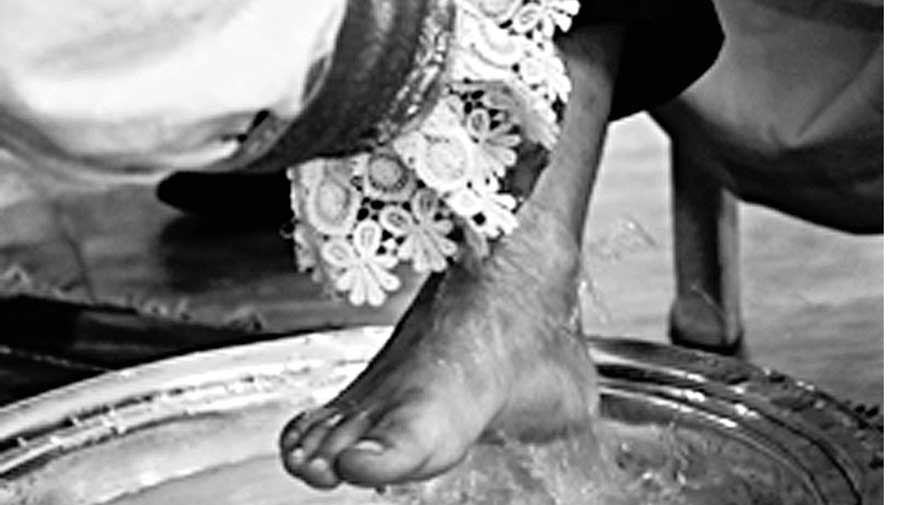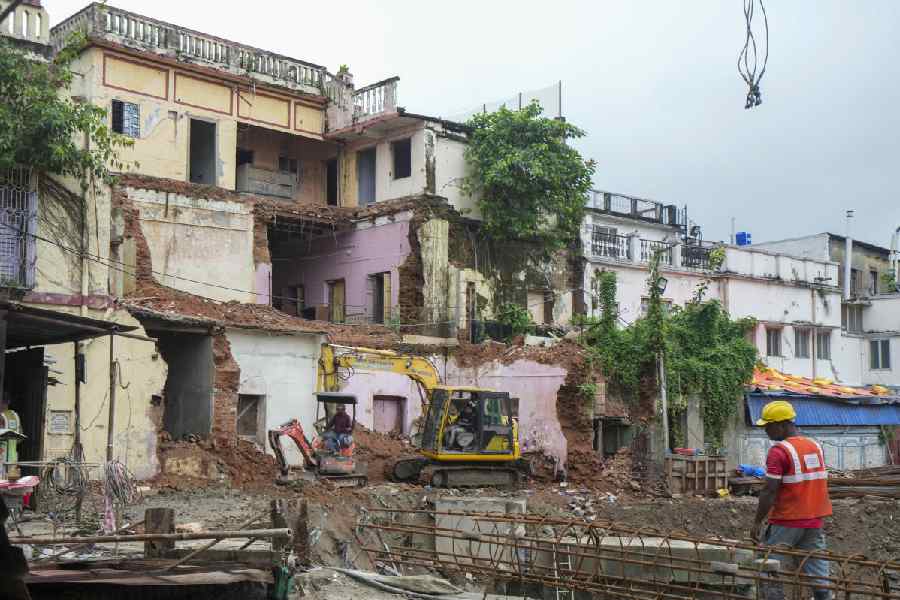Sometimes it is wiser perhaps to step back and look at what you have done. Especially if it is a book that encloses centuries.
After Alakananda Nag was ready with the first version of her book on the Armenian community of Calcutta , she felt unhappy with it, and let it lie fallow for a year or so. Then she made it again.
The result is a slim and elegant volume titled Armenians in Calcutta, part photo book, part history. It is covered in blood-red cloth and the front cover does not bear the title, which is on the spine, but a question, debossed, or imprinted on the cloth in relief: “Are the Armenians after all the founders of Calcutta?” The self-published book was launched in February at Printed Matter’s Virtual Art Book Fair and is waiting for an India launch.
Alakananda, 43, was unhappy with her first attempt because she felt she was “exoticising” her subject.
It is easy to look at the city’s Armenian community with “wonder”, says Alakananda, a Calcuttan who has recently shifted to Goa. They were “the world’s first merchants” who came to India and dominated the trade scene in this part of the world before the British came but has now dwindled into a group of about only 40-45 individuals in Calcutta, and whose past glory and contributions to the city, still glimpsed in ceremonies, institutions and photographs and memories, offer a heartrending contrast to its reduced stature now. It is easy to exoticise such a people. But the camera needs to see more. “I was ignoring the complexity of their lives,” says Alakananda. If she had kept the first version, in which she felt there was too much of herself, “it could have become any other photo book”, she says.

Alakananda Nag Alakananda Nag
Instead it is now an exploration of the community’s past and also a record of its contemporary reality. And a very telling book about the city itself.
It opens with a reference to a tomb in the cemetery on which the Armenian church in Burrabazar, possibly the oldest Christian church in the city, was built: “This is the tomb of Rezabeebeh the wife of the late charitable Sookias who departed from the world to life eternal on the 26th day of Nakha in the year 15, ie, on the 21st July, 1630.” Who was the “charitable Sookias” and how did he come to live in Calcutta 60 years before the British?
Armenians trade relations with India are said to have been mentioned in ancient Greek writings. In India, Armenian settlements had appeared in Kerala in the 7th century. Their history was always embattled and India was a refuge.
A sculpture commemorating the Armenian genocide by the Ottoman empire during World War I stands on the church grounds in Calcutta.
The conquests of Armenian lands by the Ottoman and the Safavid forces in the 15th century drove Armenians to India. The Moghul emperor Akbar welcomed them. The enterprising community spread to several parts of India, most importantly Bengal, and flourished from the 17th century. In Bengal, Armenian churches are located in Chunchura and Murshidabad too. But Calcutta would become the centre of Armenian life in India.
“When they arrived/ Over four hundred years ago/ From Rangoon Julfa Baghdad Yerevan/ Calcutta was the New Promised Land/ Trading in shellac indigo silk opium/ Building the city/ Thriving basking growing community,” writes Alakananda. She intersperses her photographs —mostly black and white, rich in detail and evocative, but unfussy, and captioned — with bits of text written by herself, as she felt that just photographs were not enough for the historical project.
The theme of blood runs through the book. One of the standout images is of a glass bottle with a stopper, filled with “red photo colour photographed as blood”. Blood is identity, nation, life, death, she says. The same bottle appears on the back cover. This photograph was printed specially in a Santiniketan studio using a 19th century process that involved shellac, the product Armenians traded. The community was part of the indigo trade too and is said to have played a role in instituting the East India Company in India. Its legacy is complex, as is its present.
Alakananda had come in contact with Armenian students as a student of La Martiniere for Girls in the city. The Armenian college in Calcutta, formally Armenian College and Philanthropic Academy (ACPA), which still remains an important centre for the Armenian community across the world, draws students from many countries and holds classes from standard I to standard X. After secondary school, many Armenian students get admitted to the La Martiniere schools, which had a close connection with the Armenian community. But after school, Alakananda had been “in a hurry to leave Calcutta” and went to college in Mumbai. She lived there till 2009, working in ad and feature films, to realise that that was not what she wanted.
She gave up her job and returned to Calcutta. During a trip to the US, she discovered her brother’s digital camera. Using it gave her “a high I had never felt” and there was no looking back, only through the lens, though she now also uses a twin-lens film camera now. After studying a course on documentary photography and photojournalism at International Center of Photography (ICP), New York, she returned to Calcutta again.

Washing of feet, an Easter tradition. Armenian Holy Church of Nazaereth. Burrabazar, 2014. Alakananda Nag
It was a serious homecoming. She even began to love the fish and rice Bengali staple, which she had rejected earlier. From around 2012, she began to photograph the Armenian community. For her, it was also a movement from the moving camera to still frames. The first version of the book was ready in 2018, which she unmade.
Photographing the community brought her close to its members. Some of them are now close friends. For her research, she depended on interviews with community members and the archives at the Armenian college library, Asiatic Society, private collectors and again, community members. “But the book is also built around an ‘absence,” she says: an absence of people, of materials. “I chose to stick to what was available in Calcutta. Which was a challenge.”
The book features landmarks: the church at Burrabazar — the Armenian Church of Holy Nazareth, as it is formally described, the centre of the community life here; the community home in Park Circus, a house for many. The most illustrious members of the community are remembered: the book comes with portraits of Sir Catchick Paul Chater, a Calcuttan who was a founding father of Hong Kong and who rescued the La Martiniere schools out of a severe financial crisis; of Arathoon Stephen, owner of Grand Hotel, and of the glamorous Gauhar Jaan, one of the first Indian performers to record music. Why should not the Armenians be considered among the founders of the city?
Also remembered is Fairlawn Hotel, the haunt of Violet, one of the last prominent Armenians in the city and grand dame, who would host the most famous names from around the world. “Her pearls, red lips, perfectly done hair, stood out in contrast to the half-awake guests at breakfast,” writes Alakananda. A mini fold within the book, like Gauhar Jaan’s, is a gallery of the old boys from the Armenian college.
But most touching, if not haunting, are the images of the Armenian community members now. The photograph of a middle-aged brother and sister, Marie and Saco Stephen, at their Chowringhee Lane home with a line of newspapers strung over their heads is moving. So is the photograph of Alvard Nikoghosyan, a young girl from Armenia, a student at the Armenian college.
The college, which provides free education, is a little marvel. Now the students have gone home. But before the lockdown, it housed about 60 to 70 boys and girls, a
number higher than the strength of the city’s Armenian community. “Parents from Armenian communities in other countries, especially where there is unrest, like Iraq and Iran, send their children here, hoping for a better future,” says Alakananda. A spot of India still acts as a refuge.
Among other things. Alakananda also speaks about a video she had made with some community members. “In that the Lord’s prayer is drowned by the sound of traffic.”











